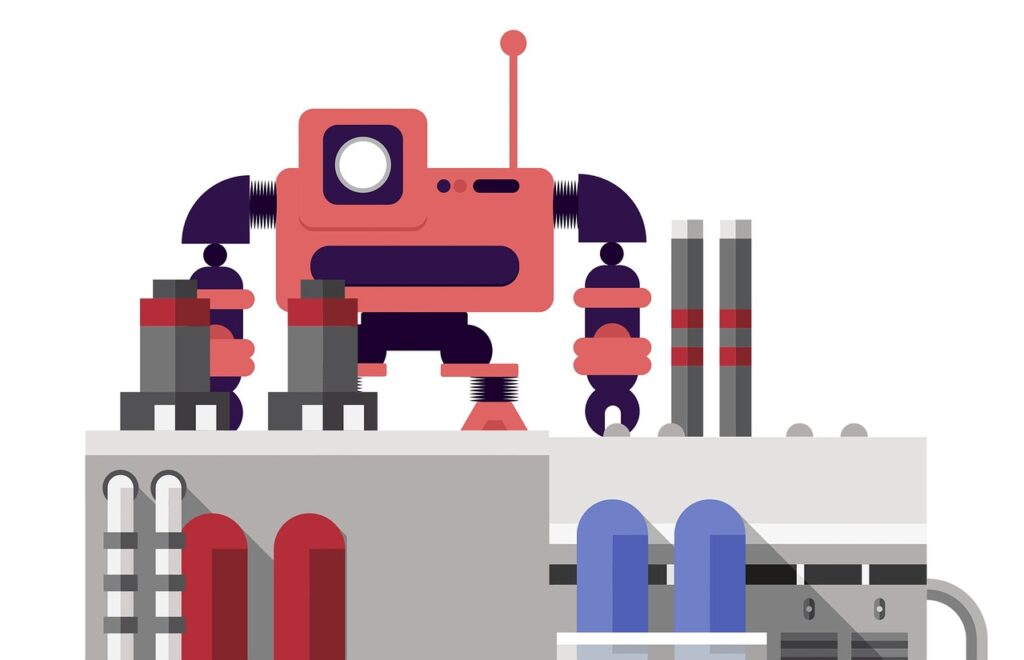Imagine a revolution in your business workflow, with Robotic Process Automation (RPA) and Digital Process Automation (DPA) serving as the change agents. With RPA taking on the repetitive tasks using software robots and DPA meticulously managing the complexities of your entire workflow, substantial time and cost savings are within easy reach. This transformative duo seamlessly fits into the larger realm of Business Process Management (BPM), yet each shines in their distinct areas of strength. RPA thrives on handling tasks that don’t require decision-making, whilst DPA excels in coordinating multifaceted processes, like welcoming and integrating a new team member with procedures kicking off at the first login. When employed correctly, both RPA and DPA have the potential to supercharge your business’s efficiency and productivity.

Understanding Robotic Process Automation (RPA)
Defining RPA
Robotic Process Automation (RPA) is a technology that references the use of software robots or bots to replicate and streamline existing tasks. These bots are programmed to accomplish tasks that are repetitive and mundane in nature, freeing up time for you and your employees to focus on activities that require strategic thinking and decision-making skills.
Ideal Use-cases for RPA
RPA is ideally suited for tasks that often seem tedious and time-consuming, yet are necessary for the smooth functioning of your business. Tasks such as data entry, scheduling system back-ups, or generating reports are perfect candidates for automation with RPA. Essentially, if a task follows a clear set of instructions to be carried out, RPA can handle it.
Benefits of RPA in Business Operations
RPA gives businesses the opportunity to increase efficiency and productivity in their day-to-day operations. By utilizing bots to handle tasks that are often time-consuming and tedious, businesses can boost operational efficiency and staff productivity by allowing them to concentrate on tasks that add more value to the organization. Moreover, because bots offer near-perfect accuracy, businesses can also benefit from a reduction in error rates, promoting higher data integrity and better service quality.
Exploring Digital Process Automation (DPA)
What is DPA
Digital Process Automation (DPA) is the evolution of workflow automation. While RPA automates individual tasks, DPA aims to streamline and automate an entire workflow or business processes. By focusing on an end-to-end process, DPA allows complex tasks within a workflow to be coordinated and managed seamlessly.
Ideal Use-cases for DPA
DPA is the go-to solution when dealing with complex processes involving multiple stages and decision points. A typical workflow that DPA can automate might include approvals, routing steps, and decision-making at various stages. These processes often involve different people working in different capacities and require coordination, artifacts collection, auditing, and more.
Benefits of DPA in Business Operations
DPA can be transformative for a variety of business operations. By automating the entire end-to-end process, DPA allows for improved workflow optimization, enhanced operational efficiency, and increased business agility. Furthermore, DPA enables companies to provide improved customer service and experiences as processes are optimized and delays minimized.
How RPA and DPA Differ
Task Suitability for RPA vs DPA
The primary difference between RPA and DPA is the nature of tasks for which they are suited. RPA excels at repetitive, mundane tasks that can follow a clear set of instructions. DPA shines in automating complex processes involving multiple stages, user personas, and decision-making points.
Complexity of Processes Handled by RPA and DPA
RPA and DPA also differ in terms of the complexity of the tasks they can manage. As mentioned before, RPA is unparalleled in dealing with repetitive tasks, while DPA is designed to manage and coordinate complex processes that require overall workflow management.
Role of RPA and DPA in Business Process Management (BPM)
Understanding BPM
Business Process Management (BPM) is an overall strategy aimed at improving an organization’s business processes and workflows. BPM involves the systematic breakdown of tasks, assessment of their efficiency, and continuous improvement.
Integration of RPA and DPA in BPM
RPA and DPA, when integrated into BPM, can drive efficiencies and bring about substantial improvements. By using these tools, businesses can automate time-consuming and repetitive tasks (RPA), as well as complex, integrated processes (DPA). This leads to a comprehensive process-management approach, synergizing the various tools in the toolbox to ensure that every aspect of business processes are as efficient as possible.

How RPA and DPA can bring about Significant Cost and Time Savings
Impact on Operational Efficiency
Implementing these automation tools into your company’s workflow can significantly boost operational efficiency. Given that both RPA and DPA reduce the need for manual labor, organizations can reassign that labor to more strategic initiatives, leading to better utilization of human resources.
Reduction in Error Rates
Automation also offers the added benefit of precise accuracy. By bypassing human error, these tools can greatly increase the level of accuracy in your business processes, leading to better outcomes and higher quality.
Real-life Examples of Cost and Time Savings
Many organizations have achieved significant cost and time savings by implementing RPA and DPA. For instance, a customer service center might use RPA to automate repetitive queries, boosting resolution times and customer satisfaction simultaneously. Alternatively, a lender may use DPA to expedite loan approval processes, making it a quicker and more seamless experience for customers.
Specific Applications – RPA for Repetitive Tasks
Why RPA is Ideal for Repetitive Tasks
RPA is ideal for repetitive tasks because it can accurately mimic human interactions with digital systems. For example, bots can be programmed to pull data from multiple systems, input that data into an application, perform computations, and generate reports, all at a much faster speed and without any errors that usually accompany manual processing.
Examples of RPA in Repetitive Task Application
RPA applications may include areas like invoice processing where the bots can extract data from invoices, input the data into the accounting system, and match the invoice with the appropriate purchase order. Similarly, in HR operations, bots can expedite the process of job applications by screening resumes and scheduling interviews with potential candidates.

Specific Applications – DPA for Complex Processes
Why DPA is Effective for Complex Tasks
When it comes to tasks involving multiple steps, stages, or decision points, DPA is your best friend. DPA systems are designed to handle these types of tasks because they take a holistic view of the process and manage each stage to ensure a smooth transition.
DPA in Action: Onboarding a New Employee
A good example of DPA is in the onboarding of new employees. When a new employee joins, the employee’s first login can trigger a series of automated tasks such as sending a welcome message, sharing training videos, submitting necessary paperwork, assigning a mentor, and more.
Combining RPA and DPA for Maximum Efficacy
Understanding the Interplay between RPA and DPA
RPA and DPA are perfect partners. They can work together to ensure that both individual tasks and overall business workflows are automated and optimized. RPA takes care of the nuts and bolts — the individual, repetitive tasks, while DPA oversees the entire process, ensuring that the whole operation runs smoothly and effectively.
Potential Synergies in Combining RPA and DPA
When combined, RPA and DPA can deliver synergies far beyond their individual capabilities. This dual approach allows tasks to be carried out with increased speed and precision, resulting in an effective, efficient, and highly reliable process that boosts productivity, reduces errors, and saves costs.
Challenges in Implementing RPA and DPA
Common Obstacles in RPA Implementation
Like any change, implementing RPA does come with challenges. These can include resistance from employees, unclear process definitions making it hard to develop bots, or even technical difficulties in integrating existing systems with RPA tools.
Difficulties faced in DPA Implementation
Similar to RPA, DPA also comes with its set of challenges. These can include difficulty in defining complex workflows, uncertainty around managing changes in workflows, or integration complications with existing systems.
Overcoming Implementation Challenges
Overcoming these obstacles requires careful planning, clear communication, and the provision of adequate support and training for employees. It’s also crucial to start small, test thoroughly, and gradually extend the use of these technologies throughout the organization.
Future Outlook of RPA and DPA in Business
Current Trends in RPA and DPA Adoption
Organizations are increasingly recognizing the value of RPA and DPA, with more and more businesses across diverse industries adopting these technologies. They are seen as a way to reduce costs, boost productivity, and create agile, efficient workflows.
Predicted Developments in the RPA and DPA Space
In the near future, it’s expected that these technologies will become more advanced and capable, managing not just simple repetitive tasks and complex processes but even larger aspects of business operations. With artificial intelligence and machine learning thrown into the mix, the future is indeed promising for RPA and DPA.
Transforming Future Business Workflows with RPA and DPA
RPA and DPA are not just about automating tasks – they’re about transforming business workflows. As they continue to evolve and improve, they will undoubtedly redefine the way businesses operate, leading to significant productivity gains, cost reductions, and ultimately, a better bottom-line performance. As such, businesses should consider their inclusion in their strategy as they navigate their way to compete in the increasingly digital and automated business environment.
